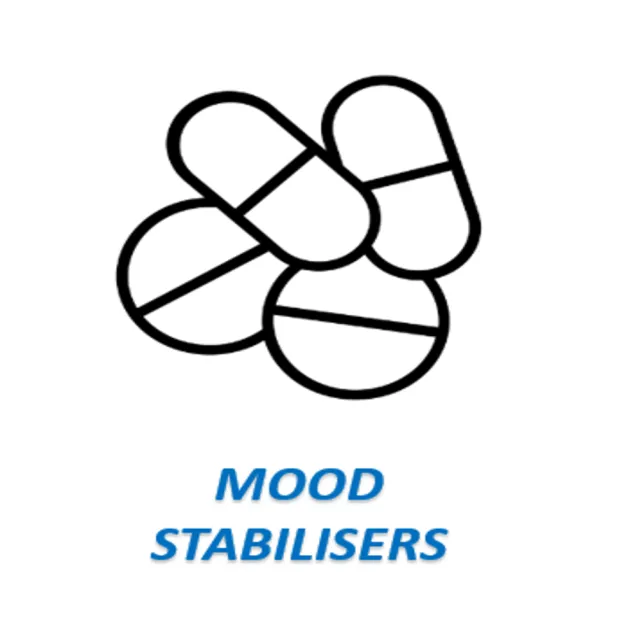Mood Stabilisers are a group of medications that are used primarily in the treatment of Bipolar Disorder. Mood Stabilisers include Lithium – a naturally occurring element, a group of anticonvulsants, and some antipsychotics.
These medicines can also be used in the treatment of other conditions like Schizoaffective Disorder, Borderline Personality Disorder, or as an adjunct for Treatment-Resistant Depression.
Mood stabilisers are a very important group of medicines, and have helped many people manage their mental health condition.

Information on Mood Stabilisers
It normally takes between four and six weeks for the full effect of a mood stabiliser to take effect. However, some minor improvements may be visible within two weeks of beginning treatment.
While mood stabilisers take effect, if the symptoms merit it, some antipsychotics can be used in the short-term – these typically work rapidly in reducing symptoms.
It is important to take mood stabilisers both how and when a Doctor has advised. This involves taking the correct dose at the right time, and taking the medication on a consistent basis.
A low dose will initially be prescribed. It is normal to take a mood stabiliser on a long-term basis. If an individual does reach remission, then they will need to gradually withdraw from the mood stabiliser. But in the majority of cases, use of a mood stabiliser will last for life.
What conditions are Mood Stabilisers used for?
Mood stabilisers can be used in the treatment of a wide array of conditions, such as:
- Bipolar Disorder
- Schizoaffective Disorder
- Borderline Personality Disorder
- Depression (Used as an adjunct)
What are the different types of Mood Stabilisers?
There are 5 main mood stabilisers that are used in the United Kingdom. These five medications can be split into three categories.
Lithium – a naturally occurring element – is the most popular mood stabiliser, though others exist in case of poor response.
Three anticonvulsants – Lamotrigine, Valproate and Carbamazepine – are also available as stabilisers. Finally, Asenapine – which is actually an antipsychotic – is also used as a stabiliser.
- Carbamazepine (Tegretol)
- Lamotrigine (Lamictal)
- Lithium Carbonate
- Sodium Valproate (Depakote)
- Asenapine (Sycrest)
As mentioned, many antipsychotics have a mood stabilising-effect, and so can be prescribed if needed. They are typically Olanzapine, Quetiapine, Risperidone and Aripiprazole.
How do Mood Stabilisers work?
It isn’t entirely understood how mood stabilisers work. Lithium is believed to effect some chemicals called neurotransmitters in the brain.
Some of these neurotransmitters like serotonin and dopamine – appear to be involved in the regulation of mood, emotion and behaviour. Antipsychotics also act on neurotransmitters – particularly limiting the level of dopamine in the brain – as excess levels of dopamine is believed to cause psychosis.
Meanwhile anticonvulsants have a different mode of action. They appear to stabilise electrical activity in the brain, which appears to result in calming manic episodes and in general, stabilise mood.
They also appear to be involved in altering different chemicals in the brain called gamma-Aminobutryic acid (GABA) and glutamate. Glutamate especially appears to be involved in episodes of depression and mania.
As mentioned above, the processes involved in stabilising mood aren’t entirely clear.
Side Effects of Mood Stabilisers
Side effects are common with mood stabilisers. However, the side effects associated with each medicine differs from medication to medication. With any mood stabiliser, a Patient Information Leaflet will be included in the box. This leaflet provides an exhaustive list of side effects.
Side effects from mood stabilisers are normally relatively mild, and should only last for a few days as the body gets used to the medication. Some side effects however may be persistent, again depending on the medication being used.
Common side effects of mood stabilisers include weight gain, stomach ache, blurred vision and drowsiness.
People taking Lithium commonly find shaking is a side effect, as is increased thirst and subsequent need to urinate.
Women taking Valproate can see an increase in their testosterone levels – leading to interruption to the menstrual cycle and abnormal hair growth. Valproate also often causes birth defects [1]. Asenapine can cause many different side effects.
Serious side effects include suicidal thoughts, seizures, chest pain, psychosis or any abnormal behaviour. An overdose should be avoided, as it can prove fatal.
Cautions of Mood Stabilisers
It is important to thoroughly read the Patient Information Leaflet that comes with your medication. The leaflet will include specific cautions that should be taken into consideration when taking a mood stabiliser.
General considerations when taking a mood stabiliser include:
- Tell a Doctor about any medicine or substance that is currently being used – such as Herbal Remedies like St. John’s Wort
- Mood stabilisers should not be stopped abruptly, as this will cause withdrawal symptoms. Instead, if an individual plans on stopping to take a mood stabiliser, they should do so slowly – involving their dosage being gradually reduced over a period of several weeks.
- Alcohol can affect the way that a mood stabiliser works. Therefore, it is recommended to not consume alcohol when being treated by a mood stabiliser.
- Mood stabilisers can react in unpredictable ways with street drugs; therefore it is advisable to not use any recreational drugs while taking a mood stabiliser.
- Bipolar Disorder and other mood disorders are associated with suicidal ideation and suicide attempts [2]. Therefore, those being treated with mood stabilisers should be monitored for suicidal ideation.
- Mood stabilisers should not be routinely used during pregnancy or when breastfeeding. Valproate especially is linked to birth defects [1]. All mood stabilisers can cause problems in breastfeeding – as small amounts of the medicines appear to pass into breast milk – causing problems for the young child. It is important to discuss this with a Doctor if relevant.
Summary
Mood Stabilisers have the potential to be very helpful for those that take them. In some cases, they are able to give a person control back over their life.
It is important to consider all of your options when deciding whether or not to take a mood stabiliser.
See Also
- Text
Disclaimer
This website should be used purely for informational purposes, and does not intend to, nor should it ever, be used as a replacement for professional medical advice.
We strive to keep all of our pages updated, and ensure that our website is full of factual and in-depth information. However, we encourage you to browse this website with care.
As a reminder, this website and all content within it cannot and should not replace the advice of a trained medical professional. You can read our full disclaimer at this link.
Helplines
If you are struggling with your mental health, help is available. With the right support and treatment, you can make a recovery. For information on helplines, or if you are in a state of crisis, please visit our crisis page by clicking on the relevant link for your geographical location (United Kingdom), (United States), (International). You can also see how to get mental health treatment and the process involved by clicking this link.
References
[1] Clayton-Smith, J., & Donnai, D. (1995). Fetal valproate syndrome. Journal of Medical Genetics. 32 (9): p724-727. DOI: https://doi.org/10.1136%2Fjmg.32.9.724.
[2] Miller, J. N., & Black, D. W. (2020). Bipolar Disorder and Suicide: a Review. Current Psychiatry Reports. 22 (6). DOI: https://doi.org/10.1007/s11920-020-1130-0.

































